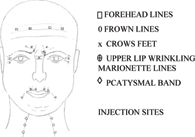Introduction
Wrinkles are part of the ageing process. They can be attributed to sun damage, effects of gravity and muscle contraction resulting from facial expressions such as frowning and laughing. Wrinkles due to the effects of gravity represent natural sagging of tissue with age and are generally only improved by surgical tightening procedures. Wrinkles caused by muscle contraction such as frown lines, forehead lines and crows' feet, can be improved by Botox treatment. The various wrinkles caused by facial muscle contraction are illustrated on diagram 1. Botox can also be used to treat excessive sweating of the armpits and palms of the hands.

Diagram 1
What is Botox?
Botox® and Dysport® are the trade names for Botulinum toxin, produced by bacteria called Clostridium botulinum. Several types of toxins have been identified, but type A, which is used commercially, is the most potent. Botox acts by blocking acetylcholine, a chemical that is responsible for transmitting electrical impulses that cause muscle contraction. This results in muscle paralysis. The resultant paralysis, however, is temporary, as the new growth of nerves will re-innervate the muscles. Botox was first used in 1978 to weaken over active muscles in the eye, followed by other neurological conditions such as dystonia and hemifacial spasm with good effects and little side effects. Botox was first used cosmetically in 1990, to reduce facial wrinkles arising from muscle contraction.
What can you expect at the time of your procedure?
Botox is injected directly into the muscles that cause the wrinkles, using a very small needle. Several injections are usually needed at specific sites, depending on the area treated (see diagram 1). When used to treat excessive sweating in the armpits, Botox is injected directed into the axillary skin. Localised discomfort and bruises can occur, but no sedation or local anaethesia is generally required. Normal activities can be resumed immediately.
What are the results?
Botox usually takes effect 24-72 hours after injection, with maximum effect at about 1 to 2 weeks. Its effects generally last for approximately 3-4 months. When injected into the muscles that are responsible for expression wrinkles, it gives the face a more relaxed and smoother appearance. Sometimes longer lasting effects (9-12 months) are seen after treatment of excessive sweating. When a gradual fading of treatment effect is noticed you may return to have another treatment.
What are the limitations?
Whilst Botox can be very effective in reducing wrinkles due to muscle contractions, it has no effect in reducing the fine lines on the face caused by sun damage, and lines due to sagging of facial skin. In those patients with very heavy lines, repeated treatments may be needed for maximum effect. Too frequent or excessive dosing of Botox may lead to patient's resistance to treatment due to antibody formation and Botox treatment may exaggerate any facial asymmetry.
What are the contraindications for treatment?
The use of Botox is contraindicated in people with neuromuscular disorders such as myasthenia gravis, those who are taking certain muscle relaxants and antibodies such as aminoglycosides, pregnant or breast feeding women, those with infection or inflammation at the proposed site of injections and bleeding disorders.
What are the risks?
No severe complications after cosmetic use of Botox have been reported in the literature. Very rarely excessive weakening of the target muscles and paresis of adjacent muscles can occur, resulting in facial weakness. This is self-limiting. When injecting above the eyebrows, upper eyelid ptosis or slight drooping may occur but only 1:100. This can be corrected with eyedrops but will also improve as the effects of the Botox wears off.
Disclaimer
This website is designed to supply useful information but is not to be regarded as advice specific to any particular case. It does not replace the need for a thorough consultation and all prospective patients should seek the advice of a suitably qualified medical practitioner. The BAAPS accepts no liability for any decision taken by the reader in respect of the treatment they decide to undertake.